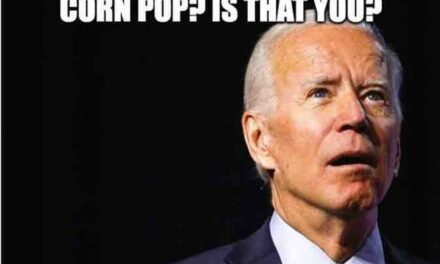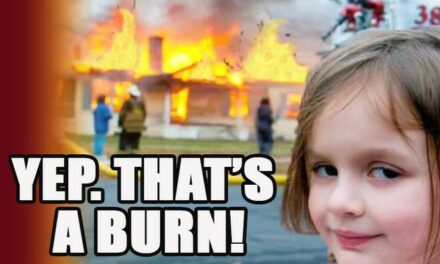We support our Publishers and Content Creators. You can view this story on their website by CLICKING HERE.
If you’re like us, you’ve probably already cast the name Aaron Bushnell onto the ash heap of history. Bushnell, you will remember, is the mentally ill Air Force reservist of immolated himself in some kind of deranged show of solidarity with the ‘Free Palestine’ movement. Hamas even congratulated him for it, which is a pretty great sign that you are on the wrong side.
Advertisement
For the insane left, however, Bushnell was — and remains — a hero. And the legacy media, being not only committed leftists but also amoral ghouls, jumped on that bandwagon hard. But that was way back in February and we thought even the media vultures had moved on from a story that had clearly flamed out (pun intended).
Not so fast, though, said New York Magazine. In a truly grotesque attempt to resurrect Bushnell’s ‘legacy,’ the publication published a lengthy ‘think piece’ late last week, examining the life of Bushnell in the most sympathetic terms.
Aaron Bushnell’s self-immolation outside the Israeli Embassy made him an antiwar martyr. What could have led to such an extreme act? https://t.co/ALa1YO0jPc pic.twitter.com/cKQjuNkHcH
— New York Magazine (@NYMag) June 23, 2024
If this sparks memories of Rolling Stone putting the Boston Marathon bomber on its cover, it should. Just like that cover story which was highly sympathetic toward Dzhokhar Tsarnaev, New York magazine’s article relishes in how Bushnell was a religious scholar (thankfully, they did not include the adjective ‘austere’), how he loved Star Wars and The Lord of the Rings, how he was shy and awkward, all characterizations designed to elicit sympathy, not condemnation.
NY Magazine committed to making martyrs for terrorists https://t.co/ermQmrnWp8
— Fusilli Spock (@awstar11) June 23, 2024
In case you were wondering which side New York magazine falls on the dilemma of whether Bushnell was a ‘martyr’ or a mentally ill extremist, writer Simon van Zuylen-Wood clears that up right at the beginning:
The spectacular way Bushnell ended his life almost guaranteed that the reactions to it would come in extremes. Many on the pro-Palestine left received Bushnell as a revolutionary figure or martyr … Stylized images of Bushnell’s blazing silhouette circulated on social media. Protesters began wearing T-shirts with his face and writings. A street was renamed for him in Jericho, and billboards and posters went up in Yemen and Malaysia …
… In the ensuing cycle of counter-takes, liberals and centrists warned against glorifying suicide, while the right received Bushnell, callously, as the victim of an epic self-own … People seemed to consider Bushnell either incomprehensibly deranged or in possession of great moral clarity …
… Posthumously, he became the poster child for a largely leader-less and anonymous antiwar movement.
Of course. He is the ‘poster child’ for a movement. The article AGREES that he is a martyr.
And if you say what he did was insane, then you are being ‘callous’ with your ‘counter-take.’
Well, if you want callous, New York Magazine, Twitter is here to deliver.
He was very committed to the cause but in the end suffered from a severe case of burnout.
— Magills (@magills_) June 23, 2024
He wanted to reduce his carbon footprint, his carbon headprint, his carbon torsoprint.
— Dave Gordon 🇺🇸 🇮🇱 (@D_Gordzo) June 23, 2024
— SRRB (@SRRB10312497) June 23, 2024
Advertisement
— Jailbird Bishop 🇺🇲 (@TheWildBishop) June 23, 2024
I’m gonna say bad decisions, combustible liquids, and a lighter. https://t.co/4DRDSBGwxc
— Forrest (@typicalfo) June 23, 2024
These responses (and so many more just like them) are to be expected on Twitter. They serve to illustrate the insanity that New York Magazine is celebrating. And far from being ‘callous,’ they highlight that no functioning person should EVER celebrate such an act or call it ‘martyrdom.’
But even better than the funny responses were the serious ones, showing how dangerous van Zuylen-Wood’s line of thinking was throughout the article.
A message from @NYMag:
Are you struggling with suicidal tendency?
Are you considering a school shooting ending in your own death?
Do you think the only way to bring meaning to your life is through your death?
GO FOR IT!!!
Once you are gone, we will give you a featured story! https://t.co/QNOZqxFlB0
— Rabbi S Litvin (@BluegrassRabbi) June 23, 2024
The rabbi’s tweet ends with this quote, ‘Once you are gone, we will give you a featured story!’
There isn’t a single sentence in the article stating that behavior like Bushnell’s leading up to his suicide should be discouraged, or should require psychiatric intervention. Not one.
My guess is that it was actual bigotry and antisemitism driven by the focused narrative pushed by the progressive left. I doubt, however, that those reasons are covered by the magazine. https://t.co/kNhaXMQx83
— Quintus Septimius Florens Tertullianus (@mwilliams433) June 23, 2024
Advertisement
That doubt would be correct. There’s nothing in the article decrying the extreme ideas that Bushnell was infected with or embraced.
Just spitballing here, but it was probably the extremism. https://t.co/siap87Z8lB
— G (@stevensongs) June 23, 2024
He was insane, and other insane people like you encouraged him. https://t.co/N4vGtYpaiP
— jimtreacher.substack.com (@jtLOL) June 23, 2024
You would also be correct in assuming that the article doesn’t spill a single drop of ink on any media self-reflection about the narratives they promote (many of which come directly from Hamas).
Martyr? What is this, the Gaza Times?
We don’t do that here 😑 https://t.co/WOclCEhEyx
— Your Highness Chrispy (@candyisyummy333) June 23, 2024
Sadly, many Western media outlets DO INDEED do that here.
Mental illness egged on by cynical activists whose antisemitism preclude their humanity. https://t.co/52Jb83NVzb
— Yore Friend Whig 🇮🇱 (@WhigJust) June 23, 2024
There is similarly no criticism, not a word, about the people who encouraged and celebrated Bushnell. Probably because the publication is one of them.
He was a mentally ill narcissist; maybe start there and you’ll unravel this fascinating mystery. https://t.co/CPa96dNQ3z
— Dan Minucci (@HouseofMourthia) June 23, 2024
Number of times the words ‘mentally ill,’ ‘narcissist,’ or ‘narcissism’ appear in the article: also zero.
I can’t imagine what might have led to such an extreme act. Perhaps we’ll never know.https://t.co/JKeumv4WVc
— Fuzzy Chimp 🇺🇸🍌 (@fuzzychimpcom) June 23, 2024
Advertisement
Sorry, we might be starting to sound like a broken record here, but guess how many times van Zuylen-Wood refers to violent, inflammatory rhetoric from politicians like ‘the Squad’ throughout his article?
If you guessed ‘also zero,’ you win.
(Sorry, we don’t have any prizes to give out at the moment, but you can bask in being 100 times smarter, more perceptive, and more informed than anyone who works at New York Magazine.)
Reading New York Magazine.
— BloomStreetBlues (@grenwuld) June 23, 2024
Now there’s an idea that probably should be investigated.
What could have led to it?
Mental illness/suicidality & indoctrination.
That you would celebrate him & his twisted act will contribute to others potentially doing the same thing. Shame on you.
— Brett (@BRHarvie) June 23, 2024
Regime propagandists are now egging on other mentally deranged leftists to die for their cause so they can be called “martyrs” https://t.co/QSDZLAFdsI
— BowTiedRanger (@BowTiedRanger) June 23, 2024
The media is openly attempting to inspire others to commit acts of martyrdom.
You don’t hate the media enough. https://t.co/Fr6dcAN2lU
— Cody Melby 🇺🇸🇲🇨🏴☠️ (@cm_19d) June 23, 2024
If you think these last three characterizations might be a little extreme in their own right, consider this:
van Zuylen-Wood ends the piece by showing some of Bushnell’s deranged text messages (we won’t reprint them here) with a comment from a friend that ‘they made sense.’ The author then concludes by stating, ‘In the end, Bushnell was violent only toward himself.’
Advertisement
With that kind of language, it is difficult to draw any inference OTHER than van Zuylen-Wood and New York Magazine consider Bushnell’s act of lunacy to be a good thing, on balance. Or at least ‘an important statement’ for his cause.
That is simply just as crazy as Bushnell’s setting himself on fire. And far more dangerous to society as a whole.

 Conservative
Conservative  Search
Search Trending
Trending Current News
Current News 






